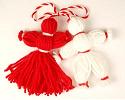      
|
Martenitsa - an Ancient Bulgarian TraditionChestita Baba Marta! (Happy Grandma Marta!) |
English for Fun <<< Celebrations around the World <<< Martenitsa - an Ancient Bulgarian Tradition |
 On the 1st of March Bulgarian people celebrate a traditional holiday called Baba Marta (or Grandma Marta in English) and it is related to welcoming the approaching spring. Peolpe all over the world meet spring with joy and new hopes but in Bulgaria it is saved as an ancient tradition. On that day, Bulgarians exchange, so called "Martenitsi" ("Martenitsa" - singular, "Martenitsi" - plural) and tell each other, "Chestita Baba Marta!" (Happy Grandma Marta!). This custom is essentially to wish great health, good luck, and happiness to family and friends. The name "Martenitsa" is taken from the Bulgarian word for March, or, as a legend tells, an angry old lady called Grandma Marta - Baba Marta in Bulgarian ("baba" means grandmother and Marta comes from word "mart", which means March in Bulgarian). In Bulgarian folklore Baba Marta is a grumpy old woman who changes her mood very rapidly and it reflects in the changeable March weather. When she is smiling the weather is sunny and warm, but if she gets angry the cold will stay for longer and it may even snow. By wearing the red and white colors of the Martenitsa our predecessors asked Baba Marta for mercy. They hoped that it will make winter pass faster and bring spring. The Martenitsa is made of twined red and white threads - woollen, silk, or cotton. The white is a symbol of strength, purity and happiness. The red is associated with health, blood, conception, and fertility. The most typical Martenitsa represents two small wool dolls - Pizho and Penda. Pizho is the male doll, usually dominating in white color. Penda is the female doll, usually dominating in red color and distinguished by her skirt. There are many other variations and forms.
Out of twined red and white threads are also made bracelets, necklaces, tassels, pompons, balls, squares, human or animal figures. Over the past several decades the tradition has been innovated by attaching all kinds of representations and symbols made of wood, leather, ceramics, metal foil to the thread-made martenitsas.
When someone gives you a Martenitsa you should wear it either pinned on your clothes, on the hand tied around the wrist, or around your neck until you see a stork, or a fruit tree in blossom for the first time in the season. After that you can tie it on a blossoming tree for fertility. It is believed that the Martenitsa bring health, happiness and longevity. Like kind of amulet, Martenitsa was attributed a magic power believed to protect folks from "ill fortune", diseases and an evil eye. The custom of wearing Martenitsa is probably one of the most interesting Bulgarian (pagan) tradition and it is considered to be unique to Bulgaria. According to one of the many legends, this tradition is also related to the founding of the Bulgarian state in 681 AD.
| |
|
| |
Site Map | Advertising | Privacy Policy | About This Project |
© Copyright 2002 - 2022. Author and design M. Boyanova. |

